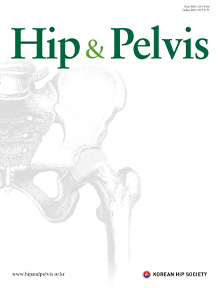Review Article
Hip Pelvis 2013; 25(1): 14-20
Published online March 1, 2013
https://doi.org/10.5371/hp.2013.25.1.14
© The Korean Hip Society
Cementless Implant in Total Hip Arthroplasty
Correspondence to : Taek-Rim Yoon, MD
Center for Joint Disease, Chonnam National University Hwasun Hospital, 322 Seoyong-ro, Hwasun-eup, Hwasun-gun, Jeonnam 519-809, Korea
TEL: +82-61-379-7677 FAX: +82-61-379-7681
E-mail: tryoon@chonnam.ac.kr
This is an Open Access article distributed under the terms of the Creative Commons Attribution Non-Commercial License (http://creativecommons.org/licenses/by-nc/3.0) which permits unrestricted non-commercial use, distribution, and reproduction in any medium, provided the original work is properly cited.
The various implants used in total hip arthroplasty can be classified according to the design and the fixation type. In general, they can be divided into two groups; cemented and cementless types. The surgeon’s decision regarding which type of implant to use should be based on the goal of the arthroplasty operation, the bony deformity of the patient, the function of the involved hip joint, and the experience of the operator. When using cementless implants, primary fixation, survival rate, and successful fixation on long-term follow-up depend on the material of the implant, the bone quality, and, ultimately, the interaction between the implant and the bone. Cementless implants have shown a high success rate in primary total hip arthroplasty and relatively fine outcomes on long-term follow-up. In comparison of the two implant types, superiority has yet to be determined, however, a choice made based on the objective of the surgery, the function of the joint, the quality of the bone, and the surgeon's experience will result in a good outcome. Therefore, we reviewed the qualities of cementless implants, the application, and the various procedures involving the implant.
Keywords Total hip arthroplasty, Cemented implant, Cementless implant
Article
Review Article
Hip Pelvis 2013; 25(1): 14-20
Published online March 1, 2013 https://doi.org/10.5371/hp.2013.25.1.14
Copyright © The Korean Hip Society.
Cementless Implant in Total Hip Arthroplasty
Taek-Rim Yoon, MD, Kyung-Soon Park, MD, Hong-An Lim, MD
Department of Orthopaedic Surgery, Chonnam National University Hwasun Hospital, Chonnam National University Medical School, Jeonnam, Korea
Correspondence to:Taek-Rim Yoon, MD
Center for Joint Disease, Chonnam National University Hwasun Hospital, 322 Seoyong-ro, Hwasun-eup, Hwasun-gun, Jeonnam 519-809, Korea
TEL: +82-61-379-7677 FAX: +82-61-379-7681
E-mail: tryoon@chonnam.ac.kr
This is an Open Access article distributed under the terms of the Creative Commons Attribution Non-Commercial License (http://creativecommons.org/licenses/by-nc/3.0) which permits unrestricted non-commercial use, distribution, and reproduction in any medium, provided the original work is properly cited.
Abstract
The various implants used in total hip arthroplasty can be classified according to the design and the fixation type. In general, they can be divided into two groups; cemented and cementless types. The surgeon’s decision regarding which type of implant to use should be based on the goal of the arthroplasty operation, the bony deformity of the patient, the function of the involved hip joint, and the experience of the operator. When using cementless implants, primary fixation, survival rate, and successful fixation on long-term follow-up depend on the material of the implant, the bone quality, and, ultimately, the interaction between the implant and the bone. Cementless implants have shown a high success rate in primary total hip arthroplasty and relatively fine outcomes on long-term follow-up. In comparison of the two implant types, superiority has yet to be determined, however, a choice made based on the objective of the surgery, the function of the joint, the quality of the bone, and the surgeon's experience will result in a good outcome. Therefore, we reviewed the qualities of cementless implants, the application, and the various procedures involving the implant.
Keywords: Total hip arthroplasty, Cemented implant, Cementless implant

Article Tools
Stats or Metrics
Related articles in H&P
-
The Value of Computed Tomography Scan in Three-dimensional Planning and Intraoperative Navigation in Primary Total Hip Arthroplasty
Fabio Mancino, MD, Andreas Fontalis, MD, MSc (Res), MRCS (Eng), Ahmed Magan, BM, BSc (Hons), MRCS, FRCS (Tra&Orth), Ricci Plastow, MBChB, FRCS (Eng), Fares S. Haddad, BSc, MD (Res), MCh (Orth), FRCS (Orth), FFSEM
Hip Pelvis 2024; 36(1): 26-36 -
Total Hip Arthroplasty in Protrusio Acetabuli: A Systematic Review
Sajid Ansari, MCh, Kshitij Gupta, MS, Tushar Gupta, MS, Balgovind S. Raja, MCh*, Pranav J., MBBS, Roop Bhushan Kalia, MS
Hip Pelvis 2024; 36(1): 12-25 -
Pathophysiology and Treatment of Gout Arthritis; including Gout Arthritis of Hip Joint: A Literature Review
Yonghan Cha, MD, Jongwon Lee, MD, Wonsik Choy, MD, Jae Sun Lee, PhD, Hyun Hee Lee, MD, Dong-Sik Chae, MD
Hip Pelvis 2024; 36(1): 1-11




 PDF
PDF Standard view
Standard view Export citation
Export citation Share
Share  Previous Article
Previous Article



